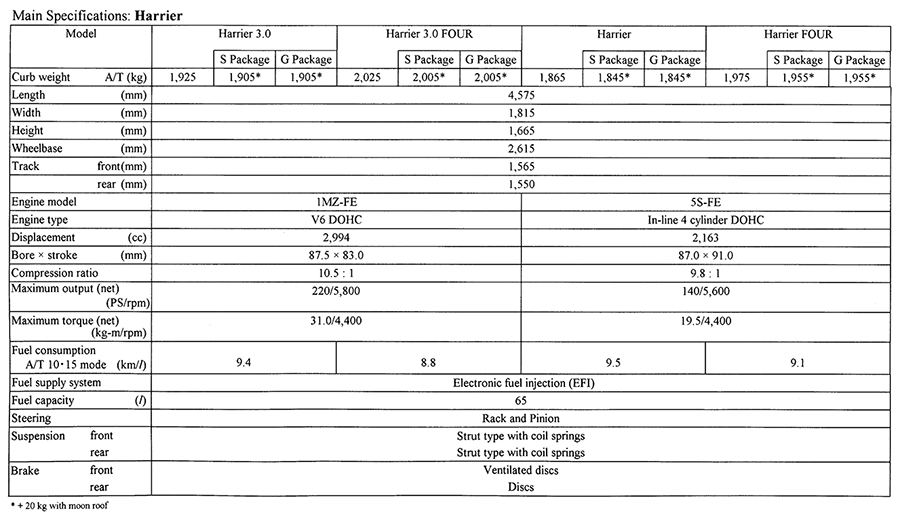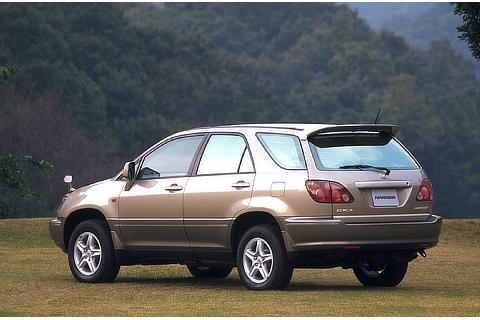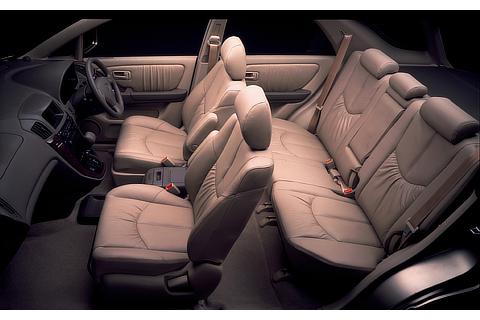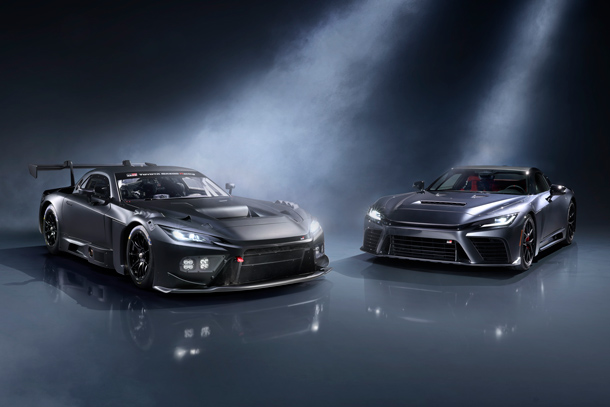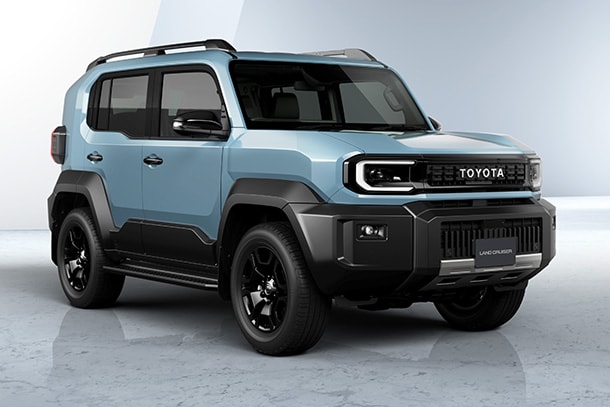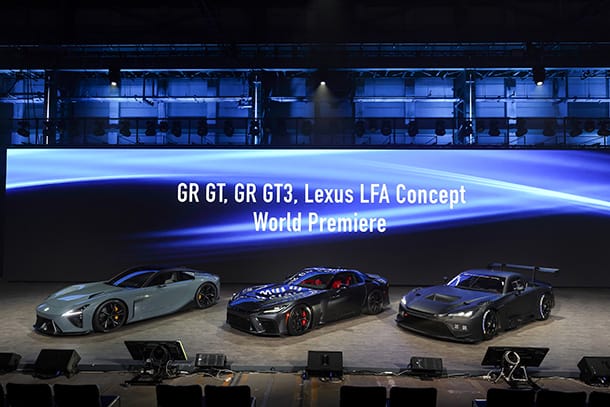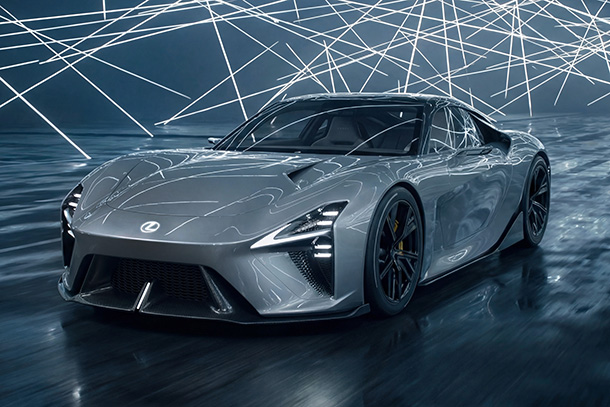Dec. 25, 1997
Toyota Launches the Innovative Harrier Sport Utility VehicleA Luxurious Twist to an Originally Rugged Concept
Tokyo―TOYOTA MOTOR CORPORATION announced today the launch of the Harrier, a new type of luxury vehicle which goes on sale today at Toyopet (at Osaka Toyota dealers in the Osaka area) and Toyota Vista dealerships throughout Japan.
The Harrier is an innovative new concept that combines the basic performance of a luxury sedan―power, handling, stability, quietness, and comfort―with the functionality and off-road performance of a sport utility vehicle (SUV). And on top of this aggressive package is an array of safety and environmental technologies.
The Harrier thus represents the emergence of a new type of vehicle that is designed to promote a more diversified and active lifestyle, but without sacrificing prestige or on-road driving pleasure.
-
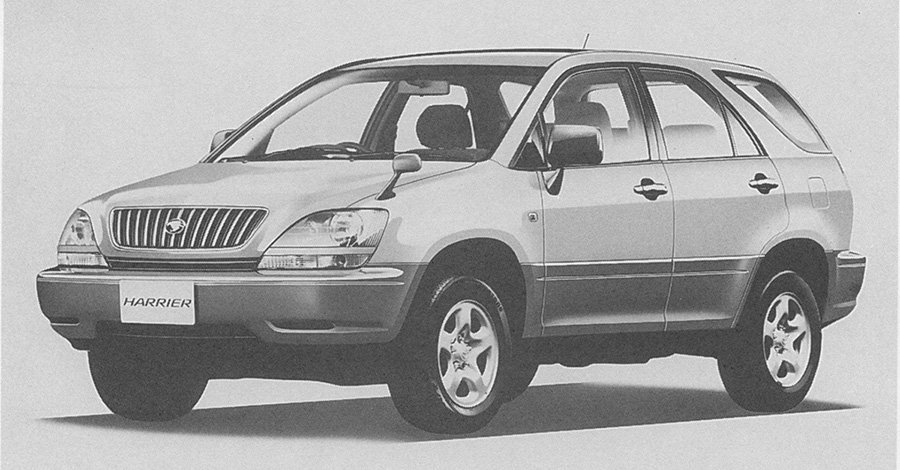
- HARRIER (with options)
Interior comfort and convenience
Although the Harrier has a minimum ground clearance of 185 mm, front seat height has been set at 725mm and that for the rear seat at 745mm off the ground. This provides enough ground clearance for the Harrier to tackle rough roads, yet the seats are low enough to allow for passengers to get in and out with ease. In addition, the interior is high enough to allow a comfortable upright seating posture.
The gear shift is located towards the bottom of the center dashboard, opening up floor space and allowing the driver and front passenger to slide easily from one side of the vehicle to the other.
The rear seats can be reclined and, in combination with the front seats, can be used to form a semi-flat area. The rear seats are divided on a 60:40 basis, and each can be positioned independently on a 120mm track to provide the flexible cabin space needed for the Harrier's many uses. Further, the rear seatbacks can be folded forward with a one-touch operation to form a large, flat luggage deck.
Power to spare
Engines
The 3.0-liter, V6 BEAMS*1 1MZ-FE engine features VVT-i*2 control that optimizes intake valve timing for engine speed and load conditions, and a three-step variable intake system (ACIS-IV*3) that adjusts the length of the intake tract to match driving conditions. The result is an engine that provides top-class low-to-mid-range torque and outstanding fuel efficiency.
- *1BEAMS
- Breakthrough Engine with Advanced Mechanism System
- *2VVT-i
- Variable Valve Timing-intelligent
- *3ACIS-V
- Acoustic Control Induction System-IV
The 2.2-liter, 4-cylinder 5S-FE engine features a pent-roof combustion chamber configuration and reduced friction loss from moving parts, which results in excellent combustion efficiency and low fuel consumption. Valve timing settings that give priority to low-to-mid-range speeds are used to make the car easier and more tractable to drive.
Outstanding road-handling, stability, quietness, and comfort
Suspension
The Harrier's 4-wheel independent suspension, with MacPherson-type struts at the front and dual-link struts at the rear, ensures a stable ride under a variety of conditions, as well as the smooth comfort of a luxury passenger car.
Performance rods built-in at the front and large, heavy-duty cross-members at the rear increase rigidity between left and right suspension units, providing the handling and stability more typical of luxury sedans.
Idling vibration is reduced by balance shafts (2.2-liter models) and by the world's first active control engine mount that use negative pressure from the engine (3.0-liter models).
The Harrier's superb NVH performance is further enhanced by a high-rigidity body, anti-vibration double-subframe structure, paneling that curves down to the front floor, and the use of anti-vibration and noise-absorbing materials at strategic locations.
Drive train
The new Super ECT, 4-speed, high-response automatic transmission is used with a high-efficiency torque converter, Flex Lock-Up system, and controls that adjust shift timing to smoothen driving when the car is going up and downhill. This is combined with Sports-Steer Shiftmatic finger controls, which allow the driver to control gear shifts without removing the hand from the wheel.
Large, 16-inch wheels that ensure ample ground clearance, together with large approach and departure angles, allow the Harrier to take rough roads in stride. The full-time 4-wheel drive system combines a viscous coupling in the center differential with an optional torque-sensing limited-slip differential (LSD). As for the rear differential on 4WD models, a torque-sensing LSD to control left and right wheel traction is available as an option.
Additional Equipment and options
Spacious seating guarantees comfort on even the longest trips. On G packages, a power-operated driver's seat is standard.
Available as an option on all models is the Wide Multi-AV Station II with GPS voice navigation and a screen that displays the status of various functions, such as the audio system, air-conditioning and FM multiplex broadcasts (for traffic and weather information).
On S packages, a JBL Premium Sound System with power amplifier and eight JBL speakers is standard equipment. The glove-box can be equipped with a multi-CD changer unit.
Clear, easy-to-read Optitron meters are provided as standard on all models to enhance legibility.
The luggage space is equipped with a deckunder-tray, deck-side bars, retaining hooks, and an accessory socket.
UV-cut glass is used for all door windows. On S packages, UV-cut privacy glass is standard on rear doors, quarter windows, and the back window.
A fully foot-operated parking brake is standard on all models.
The large center console is equipped with an ashtray, cup holders, and two drawers that serve various purposes, such as holding a cellular telephone.
Design that exudes power and prestige
Exterior
The Harrier's streamlined, wedge-shaped silhouette, defined by its steeply sloping front pillars and forward positioned cabin, the two-tier headlamps and grille, and the sporty rear combination lamps with a circle motif, all combine to project an air of power and prestige.
Interior
The luxurious interior boasts a sophisticated instrument panel design which, along with a slanting center console, creates a very personal space for the driver and front passenger.
Environmental considerations
Exhaust emissions
To reduce emissions, 3.0-liter models are equipped, directly below the exhaust manifolds on either side, with catalytic converters and sensors for precisely controlling the fuel-air mixture. Below the chassis floor also are sensors and catalytic converters to reduce emissions still further. Thus, ahead of new emissions regulations and in line with the report drawn up by the Central Environment Council, HC, CO, and NOx are reduced by more than 70% from current standards.
In order to reduce CO2, the VVT-i system (on 3.0-liter models) and reduction of friction loss have succeeded in improving fuel economy by a 3.0-liter 2-wheel-drive model to 9.4 km/L (10 15 mode).
Recycling
Toyota Super Olefin Polymer, which can be easily recycled, is used in many of the molded internal and external parts, such as front and rear bumpers, side body cladding, pillar garnish, and trim.
Lead, which is harmful to the environment, has been eliminated from materials used in the radiator and wire harnesses.
World top-class class safety features
Active safety
A higher eye-point, along with large, door-mounted mirrors and triangular side comer windows, ensure superior visibility.
On S package models, discharge head lamps with twice the brightness of halogen lamps, and with wider and longer reach, are standard.
On the passenger side, a 4-link windshield wiper is employed to clean an area approximately 10% larger than that covered by conventional wipers.
All models are equipped with an anti-lock brake system (ABS), which helps to maintain vehicle stability when the brakes are applied.
Available as an option on 2-wheel-drive 3.0-liter models is the traction control (TRC) system, which controls the drive power delivered to the wheels when starting off and accelerating under slippery conditions.
Passive safety
The Global Outstanding Assessment (GOA) safety design features a collision-absorbing body and a high-rigidity passenger cabin, contributing to the Harrier's world-class safety performance.
The pillar garnish and roof side rails have built-in impact-absorbing ribs to help absorb the impact of a collision, bringing the interior to the level required by U.S. safety standards (to be phased in starting September 1998) for protecting the heads and upper bodies of passengers.
Improvements to underbody construction and component installation restrain brake pedal protrusion into the cabin during a collision, reducing injury to the driver's legs.
Seatback frames and connection points are reinforced to protect occupants from articles on the rear deck that may be thrown forward in a frontal collision.
All models are equipped with driver and front passenger seat belts with a flashing seat-belt warning lamp, pretensioners, and force limiters.
Dual SRS air bags are standard, while SRS side air bags are available as an option on the driver's seat and front passenger seat, for all models.
The driver and front passenger seats incorporate a new structural design based on Whiplash Injury Lessening (WIL) concepts.
Sales Outline
- Sales outlets
- Toyopet (Osaka Toyota in the Osaka area) and Toyota Vista dealerships nationwide
- Monthly sales target
- 5,000 units
- Dealer announcements
- January 10th and 11th (Saturday and Sunday)
